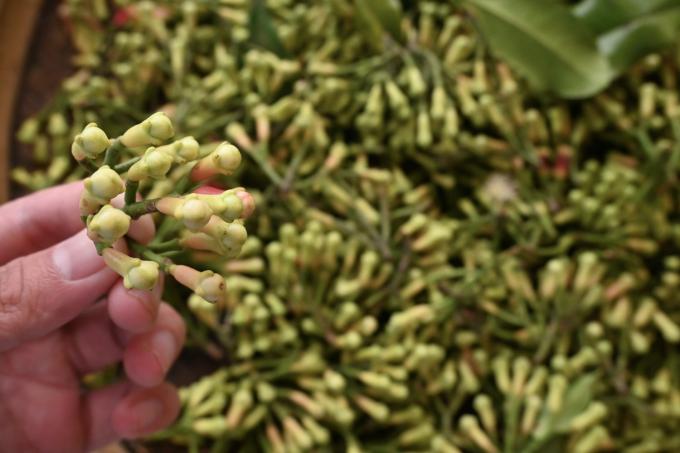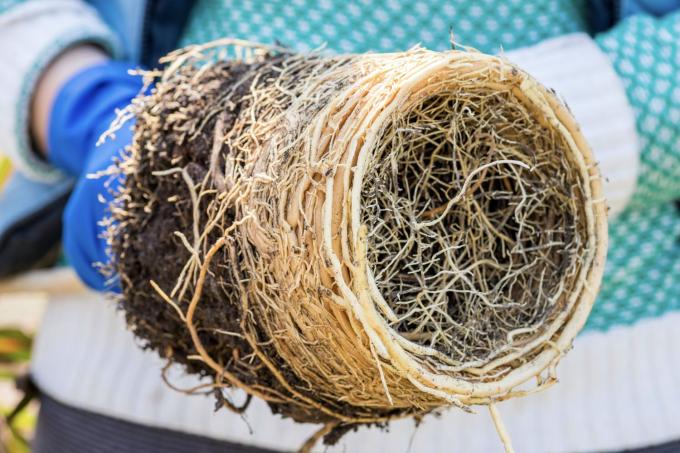You want to grow cloves in the garden yourself? You will find helpful tips on how to use, plant and care for the extraordinary clove tree with us.

Everyone knows the taste of cloves at Christmas time. But how can you cultivate a clove tree in the garden yourself? We present the special plant and reveal the best tips for planting and care.
"Contents"
- Clove tree: flower, origin and properties
- Grow your own cloves
- Care: You should pay attention to this
- Is the clove tree hardy?
- Cloves: effect and use
Clove tree: flower, origin and properties
The most important spices in Christmas baking are the dried flower buds of the clove tree (Syzygium aromaticum) indispensable. The clove tree belongs to the myrtle family (Myrtaceae) and originally comes from the famous Moluccas, the Indonesian archipelago in western New Guinea, also known as the Spice Islands will. In Europe, the dried cloves have been used since the early Middle Ages, but due to the climatic conditions, cultivation is still only possible to a very limited extent. Nowadays, the clove tree is cultivated in the tropical warm regions of the world, with mostly oceanic climates providing good growing conditions. To the flower genus of the carnation (
dianthus), which belongs to the carnation family (Caryophyllaceae), is not related at all.The evergreen tree can reach a height of over 10 meters in good conditions. If the clove tree grows in a bucket, it stays much smaller because of the limited space available for the roots. The leaves of the clove tree are leathery and juicy green. They are also egg-shaped and have oil glands through which an essential oil is released. When the clove tree blooms, you can admire a multitude of small flowers along the panicles. They have four short, fleshy petals and are hermaphroditic. The white stamens form a myrtle-typical contrast to the strong red petals. The fruits take on a dark purple to dark red color as they ripen. Inside the approximately 2 cm stone fruit there is a core through which the clove tree can be propagated. If the flower buds are harvested and dried before they bloom, the famous cloves are obtained. Their strong fragrance and pungent taste are an indispensable part of many kitchens around the world.
Tip: In the growing countries, commercially used clove trees are usually kept small by regular pruning. This is an advantage because of the high manual harvesting effort required to obtain the flower buds: the valuable carnations can therefore be reached without a ladder.

Grow your own cloves
Due to their tropical origin and the high demands on their location, it is very difficult to grow clove trees in our country. High temperatures all year round and constantly high humidity can only rarely be guaranteed. Most of the time of the year, in our latitudes, cultivation in tubs in a heated conservatory, a heated greenhouse or bright living rooms is ideal. After all, the plant can grow up to 2 meters high and occasionally flowers. During the warm summer months from May or June to the end of August or the beginning of September, the clove tree can also move outdoors - a sheltered location is very important here. Unfortunately, the clove tree does not tolerate larger fluctuations in temperature very well. Comparable with the oceanic climate of Southeast Asia, it should therefore remain as constant as possible throughout the vegetation.
In addition to the external requirements, it is also very important to constantly supply the clove plant with water without waterlogging occurring. Too wet or too dry soil would damage the fine root system of the clove tree.
Tip: To keep the humidity high, the plant should be sprayed with a little water every day. That way she feels comfortable and thrives. Small tricks can also help to give the plant high humidity: fill the saucer of the pot with expanded clay pellets or gravel, place the pot on top and fill the saucer with water - this creates a constant supply of moist air around the Plant. Or you can choose a bright bathroom as a location where the humidity is often high.
A nutrient-rich, water-permeable soil is ideal as a substrate, but at the same time has a high water storage capacity. It is best to mix high-quality potting soil with plenty of clay powder (bentonite) to increase the water storage capacity. For example, our is suitable for this Plantura organic universal soil, which already has a high water storage capacity thanks to the clay content it contains - but a further supplement can benefit the clove tree. In addition, thanks to its high proportion of compost, our Plantura organic universal soil keeps supplying nutrients and thus provides your plants with long-term care. An additional layer of expanded clay at the bottom of the bucket creates drainage that prevents waterlogging and protects the fine roots of the plant.
Care: You should pay attention to this
In order for a clove tree to be successfully cultivated, it is very important to meet its temperature requirements. The ideal temperature during vegetation is between 20 and 25 °C, temperatures below 10 °C are only tolerated for a short time. The limit of 5 °C should not be fallen below under any circumstances, otherwise damage will occur.
A constant supply of water to the plant is essential for healthy growth, the root area must not become too wet or too dry. Due to its tropical origin, the clove tree is used to heavy rain showers, which is why it tolerates heavy watering without any problems.
During the vegetation phase between April and September, the clove tree should be fertilized occasionally. A complete fertilizer like ours is suitable for this Plantura organic universal fertilizer. When used as granules, the nutrients required by the plant are only slowly absorbed Soil solution released, thus preventing salinization of the root area and having a longer-term effect liquid fertilizer. One to a maximum of two fertilizations per year are completely sufficient. The best time for fertilizing is at the beginning of the vegetation period in spring. The ideal amount of fertilizer varies between 80 and 120 grams, depending on the size of the bucket and plant. The fertilizer can be applied directly to the roughened surface of the soil, and a slight incorporation further improves the fertilizing effect. The soil surface should then be covered with some mulch material, decorative gravel or expanded clay before the plant is watered generously.
The clove tree grows slowly in the bucket, but should be repotted every two to three years to give the roots more space again. The best time for this is in April, before the start of vegetation. The new bucket should only be about 2 to 3 cm larger than the old one. The plant can be removed from the old tub and excess soil removed. A layer of expanded clay should be placed at the bottom of the bucket to prevent waterlogging. The clove tree can then be placed in the new bucket and covered with soil. A high-quality potting soil like ours is suitable for this – as with plants Plantura organic universal soil, best enriched with a few handfuls of clay powder (bentonite).

Is the clove tree hardy?
The clove tree is not hardy. This is mainly due to its tropical origin and the prevailing high temperatures throughout the year. In our latitudes, it is important to overwinter the clove tree at around 20 °C so that the plant is not damaged by the cold.
If the clove tree is grown indoors, moving during the cold winter months is not necessary. If he is outside during the summer, he should move to the winter quarters by mid-September at the latest. A heated conservatory, a heated greenhouse or bright living rooms are suitable for this – as with the location in the house. When the temperatures warm up like summer again, the clove tree can move back outside. This is usually possible after the last frost in May.

Cloves: effect and use
The buds of the clove tree were said to have healing properties as early as the Middle Ages. They were considered healthy for the brain, liver and stomach. In particular, the numbing effect when chewed made cloves the drug of choice for toothache. The fact that they also have a positive effect on bad breath was a nice side effect at the time. Today we also know that cloves are rich in antioxidants and promote fat digestion.
The flower buds are picked before they open, as soon as their color changes from green to a light pink. They are then dried, causing them to turn brown and hard. Their shape is now reminiscent of nails, which has led to countless trivial names such as Kramernagel, Nelchen or Nalen in all parts of Germany.
tip: High quality cloves can be recognized by a slightly oily surface when gently squeezed. Another indication is their swimming behavior: If the cloves are in the water or even sink and do not float on the surface, they contain oil and are therefore of high quality.

Cloves have many uses. Its head has a very fine, intense taste, while the stalk usually tastes rather bitter. As a spice, they are used to refine fish, meat, cabbage, soups or sauces or in Christmas baking as an important part of gingerbread or mulled wine. Clove oil is mainly used for cosmetics and perfumes, but is also often an aromatic component of alcoholic beverages.
The most unusual is probably the use in clove cigarettes, where up to 25% of the dried and ground clove buds are mixed with the usual tobacco. Clove cigarettes are particularly popular in Indonesia, but are consumed worldwide. About half of the global clove production is now used for the production.
Have you developed a taste for unusual spice plants? Then also read our article about Cultivation, Harvesting and Use of Cardamom.



